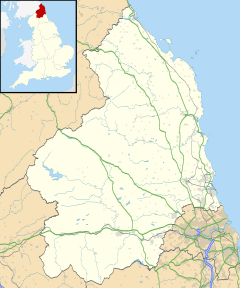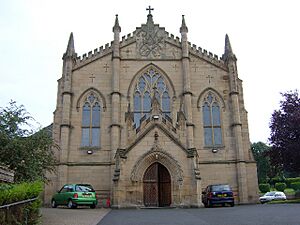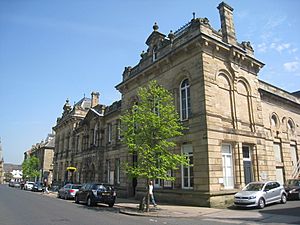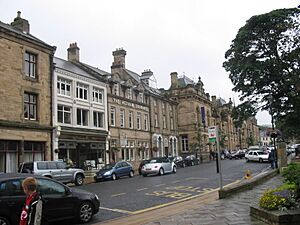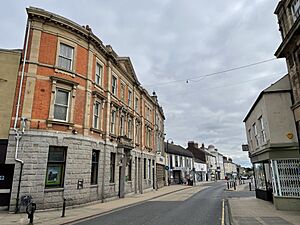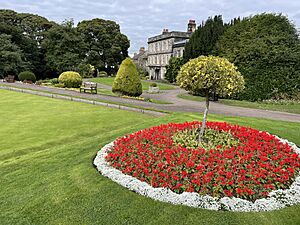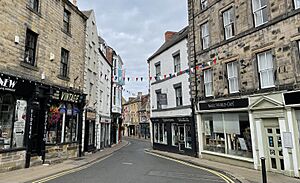Hexham facts for kids
Quick facts for kids Hexham |
|
|---|---|
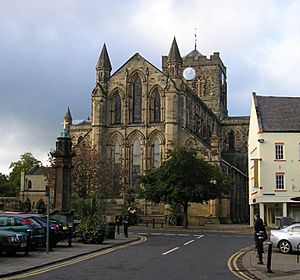 Hexham Abbey |
|
 Coat of Arms of Hexham |
|
| Population | Expression error: "String Module Error: Target string is empty" must be numeric () |
| OS grid reference | NY9363 |
| Civil parish |
|
| Unitary authority | |
| Ceremonial county | |
| Region | |
| Country | England |
| Sovereign state | United Kingdom |
| Post town | HEXHAM |
| Postcode district | NE46–NE48 |
| Dialling code | 01434 |
| Police | Northumbria |
| Fire | Northumberland |
| Ambulance | North East |
| EU Parliament | North East England |
| UK Parliament |
|
Hexham is a lively market town in Northumberland, England. It sits on the south bank of the River Tyne, close to where the North Tyne and South Tyne rivers meet at Warden. It's also very near the famous Hadrian's Wall.
Hexham used to be the main office for the Tynedale area from 1974 to 2009. In 2011, about 13,097 people lived there. Nearby towns and villages include Corbridge and Wylam to the east, Acomb to the north, and Haydon Bridge to the west. Newcastle upon Tyne is about 25 miles (40 km) east, and Carlisle is about 37 miles (60 km) west.
Contents
What's in a Name?
The name Hexham comes from old English words. It started as Hagustaldes ea, which meant "stream of the younger son." Later, it became Hagustaldes ham, meaning "home of the younger son." The word "ham" is like our modern word "home."
Hexham's History
Early Beginnings
Hexham Abbey began as a monastery (a place where monks live and work). It was started by a person named Wilfrid in the year 674. You can still see parts of the original monastery's underground room (called a crypt). This crypt was built using many stones taken from old Roman ruins nearby, possibly from Corbridge or Hadrian's Wall.
The Anglo-Saxon Chronicle, an old record of English history, tells us about a king named Ælfwald. He was killed by someone named Sicga on September 23, 788. The chronicle says a "heavenly light" was often seen where he died. King Ælfwald was buried in the church at Hexham.
Border Wars and Battles
Hexham is in an area called the Anglo-Scottish border. Because of this, it often suffered during wars between Scotland and England. For example, William Wallace attacked and burned the town in 1297.
In 1312, Robert the Bruce, who was the King of Scotland, asked Hexham for money. He demanded £2000 from the town and monastery. If they paid, he promised not to burn the town again. In 1346, the monastery was attacked again during another invasion led by King David II of Scotland.
During the Wars of the Roses in 1464, a battle called the Battle of Hexham took place south of the town. The exact spot is still debated. After the battle, the losing commander, Henry Beaufort, 3rd Duke of Somerset, was executed in Hexham's marketplace. There's a story that Queen Margaret of Anjou hid in a place called The Queen's Cave after the battle. However, it's now known that she had already gone to France by then.
Hexhamshire and the Riot
Until 1572, Hexham was the main town for an area called Hexhamshire. In 1715, a man named James Radclyffe, 3rd Earl of Derwentwater, started a rebellion in Hexham Market Place.
In the past, people in the Borders area sometimes used "Hexham" as a polite way to say "Hell". So, phrases like "Gang to Hexham!" were used.
The Hexham Riot of 1761
In 1761, a big protest happened in Hexham's Market Place. People were upset about new rules for joining the militia (a group of ordinary citizens who act as soldiers). Troops from the North York Militia fired into the crowd. About 45 protesters were killed. Because of this, the Militia was sometimes called "The Hexham Butchers."
Important Buildings
Hexham's most important building is Hexham Abbey. The church you see today was mostly built between 1170 and 1250. It's in a style called Early English Gothic. The choir, parts of the church, and the cloisters (where monks studied) are from this time.
The abbey is at the west end of the market place. Here you'll find The Shambles, a covered market built in 1766. It's a very old and important building.
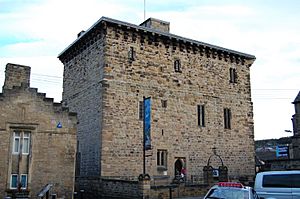
At the east end of the market place is the Moot Hall. This building was originally a gatehouse, part of the town's defenses. The Moot Hall is considered one of the best examples of a medieval courthouse in northern England.
The Old Gaol (jail) is behind the Moot Hall. It was one of the first jails in England built just for that purpose. It was constructed between 1330 and 1333.
Hexham Library and the Queen's Hall Art Centre are both in the Queen's Hall, which was finished in 1866. This building has a large collection of local history items.
Local Government
Hexham is part of the parliamentary area called Hexham. Joe Morris became the Labour Member of Parliament (MP) for Hexham in July 2024. The town is managed by Northumberland County Council and has three local areas: Hexham Central with Acomb, Hexham East, and Hexham West.
Local News and Media
The Hexham Courant is the local newspaper. It has been serving Hexham and the Tynedale area since 1864.
You can also get local news and TV shows from BBC North East and Cumbria and ITV Tyne Tees. Hexham has several local radio stations, including BBC Radio Newcastle and Capital North East.
Education
Hexham has state-run first, middle, and high schools. It uses a "three-tier system" for education, like the rest of Northumberland. Queen Elizabeth High School is the main school in the town.
Getting Around Hexham
By Air
The closest airport to Hexham is Newcastle International Airport. It's about 20 miles (32 km) away by road.
By Train
Hexham has its own train station on the Tyne Valley Line. This line was built in 1837 and connects Newcastle upon Tyne with Carlisle. The train line follows the River Tyne through Northumberland.
Trains on this line are run by Northern Trains. As of late 2019, trains go west towards Carlisle twice an hour. Three trains per hour go east towards Newcastle.
By Road
The A69 road goes through Hexham. It runs for 54 miles (87 km) from Carlisle to Newcastle upon Tyne. Another road, the A695, also connects Hexham to Newcastle, passing through towns like Corbridge and Prudhoe.
Bus Station
|
Hexham Bus Station
|
|
|---|---|
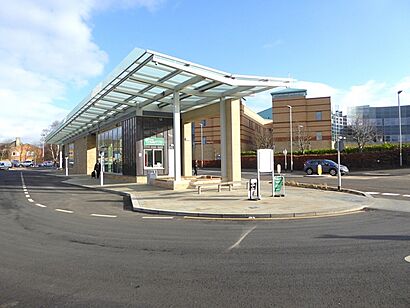 |
|
| Location | Hexham, Northumberland England |
| Coordinates | 54°58′13″N 2°05′45″W / 54.9704°N 2.0959°W |
| Owned by | Northumberland County Council |
| Operated by | Northumberland County Council |
| Bus stands | 5 (A–E) |
| Connections | Hexham |
| History | |
| Opened | 29 November 2016 |
| Location | |
Hexham's first bus station was built in the 1930s. In November 2016, a new bus station opened at Dene Avenue. It cost about £2.28 million to build.
Go North East runs most of the bus services in Hexham and the surrounding area. There's also a special tourist bus, the AD122, which runs all year. It visits many places along Hadrian's Wall. The route number, AD122, is the year Hadrian's Wall was built!
Here are some of the bus routes from Hexham Bus Station:
| Stand | Route | Destination |
|---|---|---|
| A | 10 | Newcastle (via Corbridge, Riding Mill, Prudhoe, and Metrocentre) |
| 683 | Hexham General Hospital | |
| 689 | Consett (via Slaley, Ebchester, and Shotley Bridge) | |
| B | 684 | Newcastle (via Corbridge, Ovingham, Wylam, and Heddon-on-the-Wall) |
| 685 | Newcastle (via Corbridge, Horsley, and Heddon-on-the-Wall) | |
| X85 | Newcastle (express via Corbridge and A69) | |
| C | 74 | Newcastle (via Matfen, Stamfordham, Ponteland, and Darras Hall) |
| 688 | Allendale (via Langley, Catton, and Allenheads) | |
| D | 683 | Beaumont Park |
| 685 | Carlisle (via Haydon Bridge, Haltwhistle, and Brampton) | |
| X85 | Leazes | |
| E | 680 | Bellingham (via Acomb, Wall, Chollerford, and Wark) |
| 682 | West Woodburn (via Acomb, Wall, and Barrasford) | |
| 683 | Haugh Lane Industrial Estate | |
| 889 | Alston (via Langley, Whitfield, and Nenthead) | |
| AD122 | Walltown (via Acomb, Hadrian's Wall, and Haltwhistle) |
Awards and Recognition
Hexham has won several awards. In 2005, it won the town award in the Britain in Bloom competition. In the same year, Country Life magazine named it "England's Favourite Market Town." Hexham was also voted the happiest place to live in Britain in both 2019 and 2021.
Hexham's Economy
The biggest employer in Hexham is an Austrian company called Egger. They have a factory that makes chipboard. You can often see steam from their factory from miles away.
Hexham was once very famous for making leather goods, especially gloves. In the past, many people worked in this industry. There were also tanneries (places where leather is made) and factories that made hats and wool products. Hexham has always been a busy market town, especially for buying and selling farm animals.
The Subskimmer, a special underwater vehicle, was designed and made in Hexham by a company called Submarine Products. The botanical drink company Fentimans is also based in Hexham.
Shopping in Hexham
Hexham has many shops, like other English market towns. You can find several supermarkets, clothes shops, charity shops, banks, and antique shops. There are also many cafes and coffee shops, from big chains to small family-run places.
Sports and Activities
Hexham has its own racecourse at Yarridge Heights. They hold steeplechase horse races throughout the year.
The town is also home to Tynedale Cricket Club. They play their home games at Prior's Flat. The club was started in 1888 and has been very successful in recent years, winning many championships.
Twin Towns
Hexham is twinned with two towns:
- Metzingen, Germany
- Noyon, France
People from Hexham
See also
 In Spanish: Hexham para niños
In Spanish: Hexham para niños


